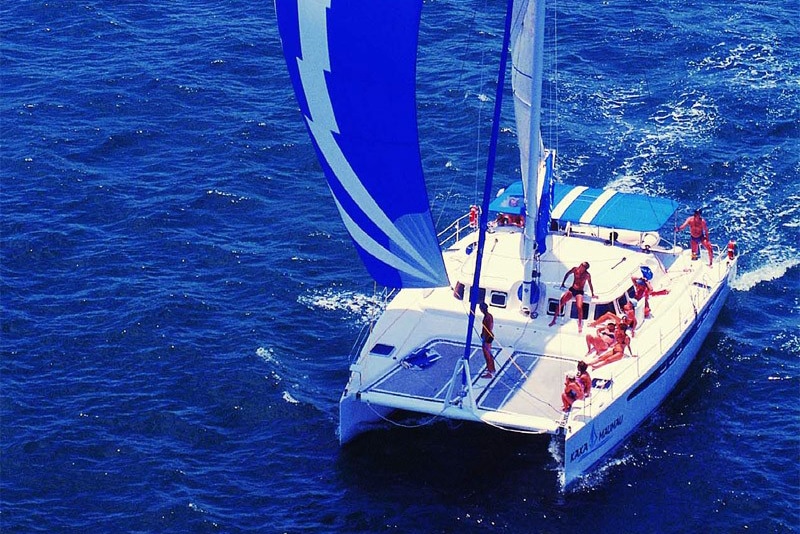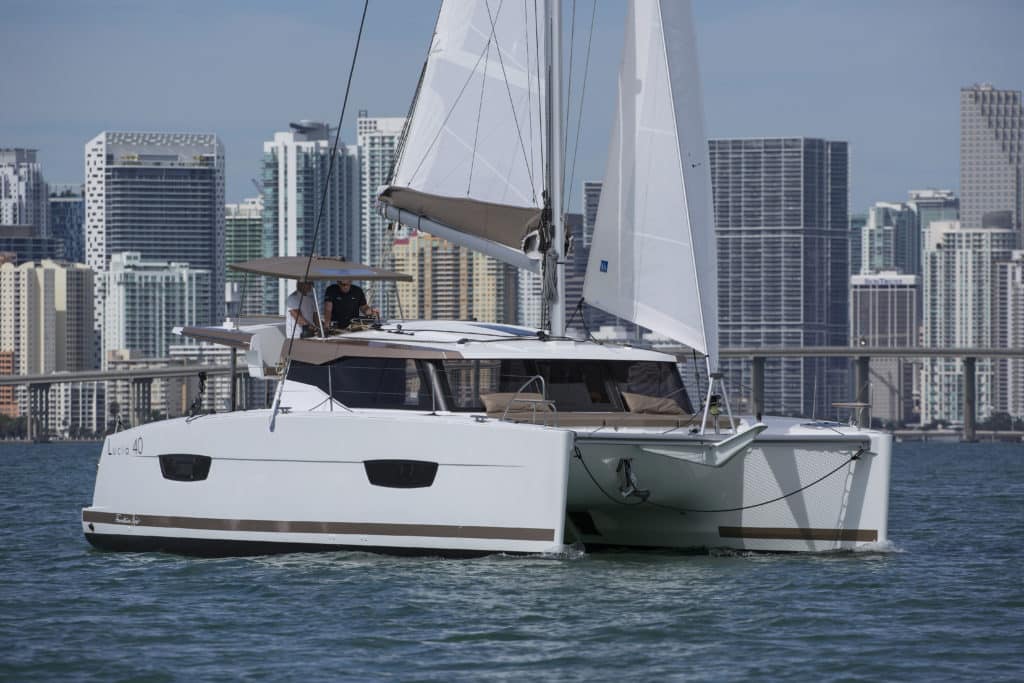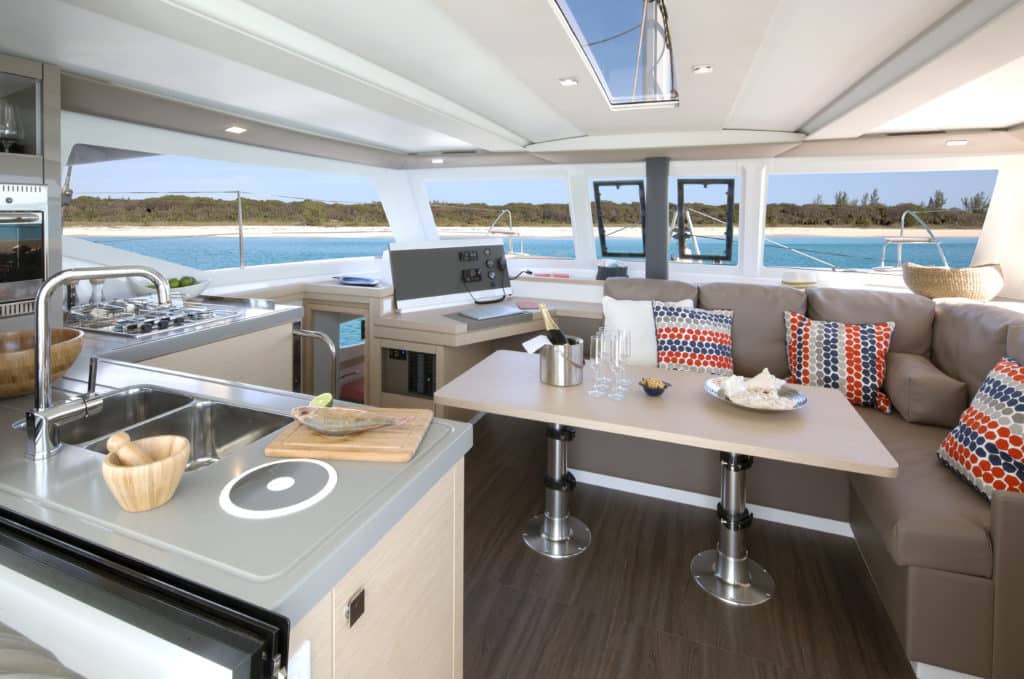
My wife, Harriet, and I have logged nearly three years and over 14,000 miles of full-time cruising on our Dolphin 460 catamaran,* Hands Across the Sea*. We frequently get asked about how we made the decision to sail on a cat. Our questioners don’t ask about obvious matters, such as interior room (cruising cats have about 60 percent to 70 percent more usable living space than same-length cruising monohulls, or the drawback of being charged double for a marina berth. They ask about issues that we, as lifelong monohull sailors, also wondered about before we began researching cruising cats.
Our answers, like those of most cruising sailors, are colored by our experience with our own boat. But because I’ve also sailed, in the course of boat reviews for magazines, over two dozen cruising cats-measuring from 30 to 57 feet-I’ve had a wide enough look at modern cruising catamarans to realize that there’s no single correct answer to every question. As with the smorgasbord of single-hulled cruising boats, cruising catamarans come in a mind-boggling variety of sizes, shapes, prices, and purposes. There really is something out there for everybody. So let the questions now begin!
6 Questions We Always Get
1. How fast does it go?
Well, that depends on a cat’s size and design, its sails, and how heavily loaded it is for cruising. First of all, when attempting to compare a cat with a monohull, try to pick boats of a similar length and performance pedigree. And realize that the conclusions you’ll reach will be nothing more than general guidelines. That said, I believe you can expect to make passages 20 percent to 30 percent faster aboard a cruising cat. On Hands, we’ve averaged 8 knots on passages of 1,000 to 2,000 miles without pushing the boat by carrying a lot of sail or taxing our mom-and-pop crew. As a doublehanded team, it’s crucial that we stay well rested, so our focus at sea is concentrated on off-watch comfort and not breaking gear rather than on all-out speed. That means easing off the throttle by reefing the sails, especially in boisterous seas, to ease the motion. But we’ve still been impressed with our cat’s ability to knock off the miles without knocking us out. Our “speed record” on Hands is 19.2 knots, surfing under main and jib in 28 knots of wind; at the time, the autopilot was steering. Yet we’ve met plenty of cat owners who are happy with 6-knot passages. Speed is exciting for them but secondary. They’re more thrilled with the ability to go from A to B without the heeling, rolling, and yawing of a monohull.
Cruising cats make good “powerboats” as well. For best fuel economy, cats usually run only one engine at a time and use both engines only when punching into head seas. For example, Hands powers at 7 knots with one engine at cruising speed (2,400 rpm), at 8 knots with both engines, and at 9 knots with both engines at full throttle. Thanks to the stability of two hulls, cats are balanced and steady platforms under power; it’s not necessary to have the mainsail up to stop the boat from rolling. And two engines provide handy twin-screw handling when it comes to docking.
2. Does it go to windward?
Without daggerboards, a cruising cat’s performance to windward is mixed; so-called “minikeels” don’t cut it. On a performance cruising cat with deep daggerboards, windward ability is far better-but usually still a bit shy of a similarly pedigreed cruising monohull. Why? In my experience, cruising cats simply aren’t set up to sail to windward efficiently. The typical three-stay, backstayless rig is prone to excessive headstay sag, which hurts pointing, and the low-aspect-ratio mainsail and headsail (and often, their sheeting arrangements) aren’t efficient for closehauled work. The windward performance of our own boat, which has 7-foot-6-inch daggerboards, was disappointing until we cranked the shrouds tight enough to minimize headstay sag. We also learned, by experimenting with sail trim, to sheet the mainsail quite hard to reduce leech twist; these tricks work wonders on a cruising monohull, too.
With her new setup, Hands sails at 7.5 to 8.5 knots in 15 to 18 knots of wind and tacks through 100 degrees, as measured by the boat’s GPS course over ground. When quantifying windward performance, don’t use the ever-dubious apparent-wind-angle readout. Instead, use the COG on your GPS as a way to measure how your boat points and how much leeway it makes. In steady winds, make several tacks five minutes apart, then take the average of the tacking angles to minimize the effect of subtle wind shifts and velocity changes. Of course, most of the cat cruisers we’ve met own cats without daggerboards, and they’re happily crossing oceans and exploring coastal areas-even though their boats don’t go to windward like a 12-Meter. One final thought: Given that the vast majority of the world’s cruising routes are downwinders, how much windward ability do you actually need in your cruising boat?
3. What’s the motion like?
One word: different. At sea, a monohull’s roll, heel, and yaw are familiar-not enjoyable, just familiar. A cruising cat serves up an alternative palette of motions: up, down, sideways, forward, aft. In almost all conditions, a cat’s moves are quick, but they’re small in amplitude. In real terms, this means that the rowdy sea conditions that send books and bodies flying on a monohull probably won’t spill your coffee on a cat. Sailing upwind in windy, choppy stuff, a cat’s motion is a kind of quick thrusting coupled with occasional sessions of hobbyhorsing-not something you want to do all day, unless you have to. But thanks to hull sections that are gently rounded, a cat doesn’t pound. As far as heel, you’ll get 4 degrees: In 12 knots, in 20 knots, in 30 knots of wind, you’ll heel 4 degrees. This is something that’s very easy to get used to. Downwind, life is good: A cat absolutely doesn’t roll, and the two widely separated, relatively narrow hulls minimize yawing; unlike the corkscrewing of single-hulled boats, cats exhibit superior directional stability. Monohull sailors are inevitably disappointed with a cruising cat’s lack of “feel” on the helm, but two hulls do make the autopilot’s job a lot easier.
A cat isn’t a magic carpet ride, however. In breezy conditions and rough seas on the beam, the motion can turn hyper: a quick dip to leeward, bounce up and straddle the wave, a quick bit of heel to windward on the backside. Lather, rinse, repeat. Harriet and I have both been seasick on Hands, and each time it’s because we’ve been driving too fast on a bumpy road. Taking your foot off the gas-reefing down-always eases the ride.
When moving fast, cats are noisier belowdecks than monohulls because water is rushing past two hulls instead of one. And almost all cats suffer, given rough and confused sea conditions, the thunderclap of chop smacking the wide, flat panels of the underside of the bridgedeck. At first the sound is alarming. With experience, it becomes an occasional annoyance. But it’s never a danger to a cat’s structure; the bridgedeck is a major structural component of a cruising cat, and it’s very strongly built. A high bridgedeck avoids the booms, but how high is high enough? The bridgedeck on Hands is about 27 inches high, and I consider that to be an acceptable minimum. Cats with bridgedecks nearly kissing the water at anchor-well, their crews are in for a very noisy ride offshore.

4. Can a cat carry a full cruising payload?
Yes, but there’s some truth to the saying “Overload a cat and it becomes a dog.” A cat’s bonanza of interior space must be treated carefully. Too much weight sabotages a cat’s high-end speed potential; gain too much weight, and you’ll still be sailing faster than most monohulls, but double-digit speeds will become elusive. So you’ll need to restrain your worst packrat/four-spares-of-everything instincts. On 46-foot Hands, even as we’ve added heavy equipment to the boat (four anchors and lots of chain, a 1,400 amp-hour battery bank, a washing machine, a watermaker, a hydronic heating system, and more), we’re continually cleaning house to save weight and stave off the clutter monster. Such winnowing will continue.
5. Do you feel safe offshore on a cat?
Yes. When a catamaran is holed, it’s reassuring to know that while it may swamp, it will rarely sink. Hands, for example, has three watertight crash bulkheads in each hull and several sealed, watertight sections beneath the cabin sole. On a cat, there’s also the built-in safety/redundancy factor of two engines and two rudders; break one, and you’ve still got one left. In fact, the more I cruise on a cat, the riskier seems the prospect of heading offshore in a monohull that can sink in 60 seconds and has only one engine and only one rudder.
6. What about capsize?
The tremendous stability of a cat simply has to be experienced to be believed, understood, and appreciated. Working on deck is safe; a cat barely heels and doesn’t suffer knockdowns. Through blasts of wind and steep seas that would’ve slapped down or broached a similarly sized monohull, we’ve stayed firmly on two wheels. Having been through it firsthand, I’m a believer in the cruising catamaran’s simple formula for awesome stability: buoyancy leveraged by lots of beam. Hands, for example, has 24 feet of beam. That said, one must exercise prudent seamanship when heading offshore in a cat. Harriet and I know that it’s “game over, wait for rescue” if we’re stupid enough to flip the boat. However, on Hands that would mean flying a full main and jib, sheeted tight, in 50-plus knots of wind on the beam-but note that the main shroud is designed to fail before the boat can be overturned. And let’s get real: If our seamanship is that bad, we shouldn’t be out there. On any boat.

3 Questions We Wish People Would Ask
1. How’s a cat at anchor?
Considering that most cruisers spend 99 percent (OK, maybe only 98 percent) of their time at anchor, this isn’t a dumb question. The simple answer is: Cats shine at anchor. They don’t roll; when the dinner plates go flying on the monohull next door, the worst you’ll get is a waddle. At anchor or on a mooring with a bridle led to the tip of each bow, cats barely “sail” like a monohull can. On Hands, we rode out a gale on a mooring to leeward of a 44-foot performance cruising monohull. While they tacked continually through 140 degrees, sailing back and forth, heeling to each gust, we tacked through only 30 degrees and stayed flat. Also, all cats have a safe-at-sea, convenient, out-of-the-way spot between the sterns for hoisting and stowing the ship’s tender. And finally, the “loading dock” cutaway-stern design of modern cats means that tender-to-boat access is superior to that of most monohulls.
2. What’s the most important equipment for a cat?
In my opinion, the best thing you can do for a cruising cat is get well-cut sails of low-stretch material. It’s my observation that for cats longer than about 35 feet, crosscut Dacron sails are just too stretchy to handle the loads. Headsails morph into bloated bags as the wind picks up, and mainsail leeches dump off to leeward; this means poor performance, especially to windward. On Hands, we have a full-batten Spectra mainsail with 12 feet of roach, a carbon/Dyneema self-tacking jib, and a large Cubenfiber screacher for light-air and downwind work, all by North Sails. Equip your cat with great sails and the boat will perform in accordance with its design intentions.
3. Would you go back to a monohull?
No-and we haven’t met any cat sailors who would. The first time Harriet and I went long-distance cruising, in the 1980s, we sailed a 15,000-mile route three-quarters of the way around the Pacific on board a heavy-displacement, full-keeled cutter. When we decided in 2006 to go cruising again, we approached the question of which type of boat to get with an open mind. After a lot of research that included hands-on testing, we chose two hulls-and we’re glad we did. But since then, we’ve found that there’s an inevitable one-two combination of ignorance and prejudice that cat owners run up against. Ours occurred when a veteran cruiser took a tour of Hands-during which he referred to our hulls as “pontoons”-and ended up announcing, “I could never get a cat. They just aren’t real boats.”
But the majority of monohull sailors are indeed curious, if cautious, about cats for cruising. They wonder, while trying to sift through anti-cat myths and pro-cat hyperbole, about these odd-looking craft. Cat sailors, meanwhile, have already discovered that there’s another way to go cruising. They know that it’s possible to sail flat and fast and safe and to cruise with all the comforts of home. So is it crazy for cruising sailors to consider buying two hulls instead of one? The journey starts with an open mind.
Tom and Harriet Linskey continue to cruise aboard Hands Across the Sea (www.handsacrossthesea.net) and bring educational, healthcare, and environmental help to island communities in need.








